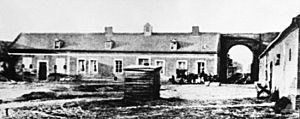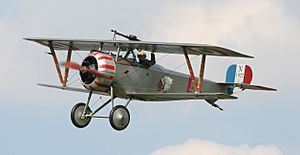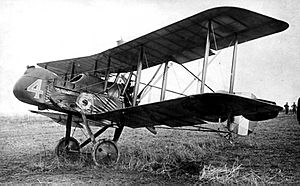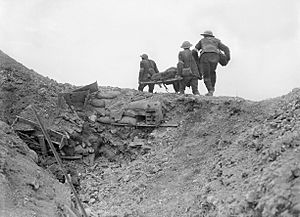Battle of Thiepval Ridge facts for kids
Quick facts for kids Battle of Thiepval Ridge |
|||||||
|---|---|---|---|---|---|---|---|
| Part of The Battle of the Somme of the First World War | |||||||
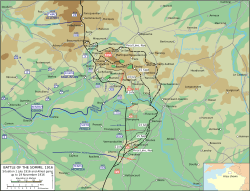 |
|||||||
|
|||||||
| Belligerents | |||||||
|
|
|||||||
| Commanders and leaders | |||||||
| Douglas Haig Hubert Gough Joseph Joffre Ferdinand Foch |
Crown Prince Rupprecht Max von Gallwitz Fritz von Below |
||||||
| Strength | |||||||
| 6 divisions | 3 divisions | ||||||
| Casualties and losses | |||||||
| 12,500 | 2,300–2,329 prisoners | ||||||
The Battle of Thiepval Ridge was a major attack by the British army during the Battle of the Somme in World War I. It took place on the Western Front in France. The battle started on September 26, 1916, and lasted for three days. The main goal was to capture Thiepval Ridge, a high piece of land that the German army had strongly fortified.
The British hoped to gain an advantage by attacking right after another big battle. The fighting stretched from Courcelette in the east to Thiepval and the Schwaben Redoubt in the west. This area was important because it overlooked German defenses.
The German soldiers on Thiepval Ridge fought very hard. The British faced difficulties coordinating their soldiers and artillery after the first day. This was because the battlefield was a confusing maze of trenches, dugouts, and shell holes. The British finally reached their main goals later, during the Battle of the Ancre Heights.
Contents
Preparing for Battle
British Army Plans
Before the battle, British commanders discussed the best ways to attack. Some thought that sending soldiers in a single line was better. This would help them avoid German artillery fire, which often hit supporting lines. They also preferred afternoon attacks, as these had been more successful.
The British prepared carefully for the attack. The 18th (Eastern) Division trained for three weeks. Commanders studied the land and learned from recent battles. Engineers and soldiers dug new trenches and improved old ones. They also fixed roads to move supplies and wounded soldiers safely.
The British planned to attack on September 26 at 12:35 p.m. General Sir Douglas Haig wanted to push the Germans off Thiepval Ridge. The attack involved two main groups of soldiers: the Canadian Corps and the II Corps. They aimed to capture several key German strongholds, including the Zollern Redoubt, Stuff Redoubt, and Schwaben Redoubt.
The British had many guns ready for the attack. This included about 230 heavy guns and 570 field guns. They also used new techniques. Gas shells were fired, and machine guns shot over the heads of their own advancing troops. The plan was for the artillery fire to move forward slowly, allowing the infantry to follow closely behind. Six of the eight available tanks were also used to help the attack.
German Army Defenses
The German army had strong defenses on Thiepval Ridge. The 7th, 8th, and 26th Reserve Divisions held the front lines. Thiepval village itself was very well protected. Its cellars were turned into tunnels for storage and shelter. The village also had 144 deep dugouts.
One important German position was Mouquet Farm, east of Thiepval. It was very isolated and hard to defend. The Germans also had strongholds like Zollern Redoubt, Stuff Redoubt, and Schwaben Redoubt. These were key points in their defense lines. German soldiers had been in Thiepval since 1914 and knew the area well. They were ready for an attack.
The Battle Begins
First Days of Fighting (September 23–26)
The British artillery bombardment started on September 23. Over the next few days, they fired thousands of shells. On September 24, gas shells were fired into Thiepval to silence German guns.
A small attack on Mouquet Farm began on the evening of September 24. British soldiers reached the farm, but German fire forced them back.
On September 26, the main attack began at 12:35 p.m. The Canadian Corps and II Corps advanced behind a moving wall of artillery fire.
On the right side, Canadian soldiers faced heavy German fire. Two tanks helping them got stuck early on. Despite this, some Canadian units reached the German front line quickly. They captured their objectives and held them against German counter-attacks.
The 1st Canadian Division also attacked with two brigades. They fought hard to reach their goals, pushing through German defenses. They captured Zollern Trench and Hessian Trench, but faced strong machine-gun fire.
West of the Canadians, the 11th and 18th (Eastern) divisions attacked. The 11th Division fought through Zollern Redoubt. The battle for Mouquet Farm continued, and after a long fight, the remaining 56 German soldiers surrendered. The 11th Division reached Schwaben Trench and Hessian Trench.
The 18th (Eastern) Division also advanced well. Their plan to avoid German counter-fire worked. They reached their first objective in just 12 minutes. Two tanks helping them got stuck. The advance through Thiepval village was slow. Machine-gun fire from the château ruins held them up until a tank helped. By 2:30 p.m., most of Thiepval was captured.
Continuing the Fight (September 27–30)
On September 27, German artillery bombarded the Canadian positions. Later, patrols found that the Germans had pulled back. The Canadians advanced and took more ground. They faced fierce counter-attacks but held their positions.
In the II Corps area, the 11th Division found Zollern Redoubt empty and occupied it. They tried to advance further but were stopped by machine-gun fire from Stuff Redoubt. Later, they captured part of Stuff Redoubt and Hessian Trench.
The 18th (Eastern) Division continued its attack. By 11:00 a.m. on September 27, all of Thiepval was captured.
On September 28, the Canadians tried to advance further but were stopped by machine-gun fire from Regina Trench. The 18th (Eastern) Division attacked Schwaben Redoubt. They captured the south side of the redoubt and linked up with other British troops. By 8:00 p.m., the west side of the redoubt was also taken.
On September 29, the 3rd Canadian Division attacked Hessian Trench, gaining and losing ground in fierce fighting. The 11th Division attacked Stuff Redoubt again, capturing most of it. The 18th (Eastern) Division fought all day around Schwaben Redoubt.
On September 30, the 11th Division attacked Stuff Redoubt again, taking its southern half. A German counter-attack pushed the 18th (Eastern) Division out of parts of Schwaben Redoubt, but they recaptured the south side. Another German attack later retook the north face.
Air Operations
Planes played an important role in the battle. British planes flew low to check German defenses before the attack. During the battle, air observers watched the infantry advance. They reported when British troops entered Thiepval, which made some German soldiers run away.
Aircraft also helped direct artillery fire, identifying German gun positions. One observer even reported about 1,000 German troops on a road, who were then scattered by British heavy artillery. British planes dropped bombs on German trenches, artillery, and buildings. They also attacked German observation balloons, shooting down two with rockets.
On September 27, heavy rain stopped most flying. However, six British planes were attacked by five German Albatros D.I fighter planes, which shot down three. German fighter squadrons, called Jagdstaffeln, were new and had better planes.
On September 28, British planes reported advances at Schwaben Redoubt and helped direct artillery fire. Few German planes appeared, but two were shot down. Bad weather continued on September 29. On September 30, the weather cleared, and British planes took many photos. They also raided a German airfield again.
German Army's Response
The German 7th Division quickly lost its front trenches near Courcelette. However, some German units managed to ambush the Canadians. The Canadians outflanked the Germans, forcing them to surrender. The Canadians pushed forward, capturing Zollern Trench.
The German 8th Division held strong positions around Zollern Redoubt and Thiepval. The defense of Thiepval collapsed when three British tanks appeared. These tanks were not affected by machine-gun fire or grenades. British infantry quickly overran German positions, with very few Germans escaping.
The German soldiers in Zollern Redoubt held on, helped by accurate artillery fire. Mouquet Farm was surrounded but held out for a while. The Germans were forced to pull back to new defense lines.
The 26th Reserve Division held Thiepval and Schwaben Redoubt. They saw the British digging trenches before the attack, so they were ready. The first two waves of British infantry were shot down. But then a tank led a third wave, which reached the German positions. British soldiers also attacked from behind, causing the German defense to crumble. The Thiepval garrison lost about 75 percent of its soldiers.
After the Battle
Soldier Losses
The 1st Canadian Division lost 6,254 soldiers in September. The 11th Division lost 3,615 soldiers, with about 70 percent wounded. The 18th (Eastern) Division lost 4,000 men.
German losses are not as clear, but September was the costliest month for the German armies on the Somme. They lost about 135,000 soldiers. The British Reserve Army captured 2,300 to 2,329 German prisoners, along with 27 guns, 200 machine guns, and 40 trench mortars.
What Happened Next
British operations continued after September 30. They captured a large part of the Schwaben Redoubt, which had been a goal from the first day of the Somme battle. In the Battle of the Ancre Heights, which began on October 1, the British finally reached all the goals of the Battle of Thiepval Ridge. The rest of Schwaben Redoubt was captured on October 14. The Canadian Corps finished capturing Regina Trench on November 11.
Remembering the Battle
Because Thiepval was such an important target that took a long time to capture, a special memorial was built there. The Thiepval Memorial to the Missing of the Somme honors soldiers who died in the area from 1916 to 1918 and whose bodies were never found. The memorial has the names of over 72,000 British soldiers who were killed on the Somme battlefields.
See also
- List of Canadian battles during World War I
- Ulster Tower Thiepval



